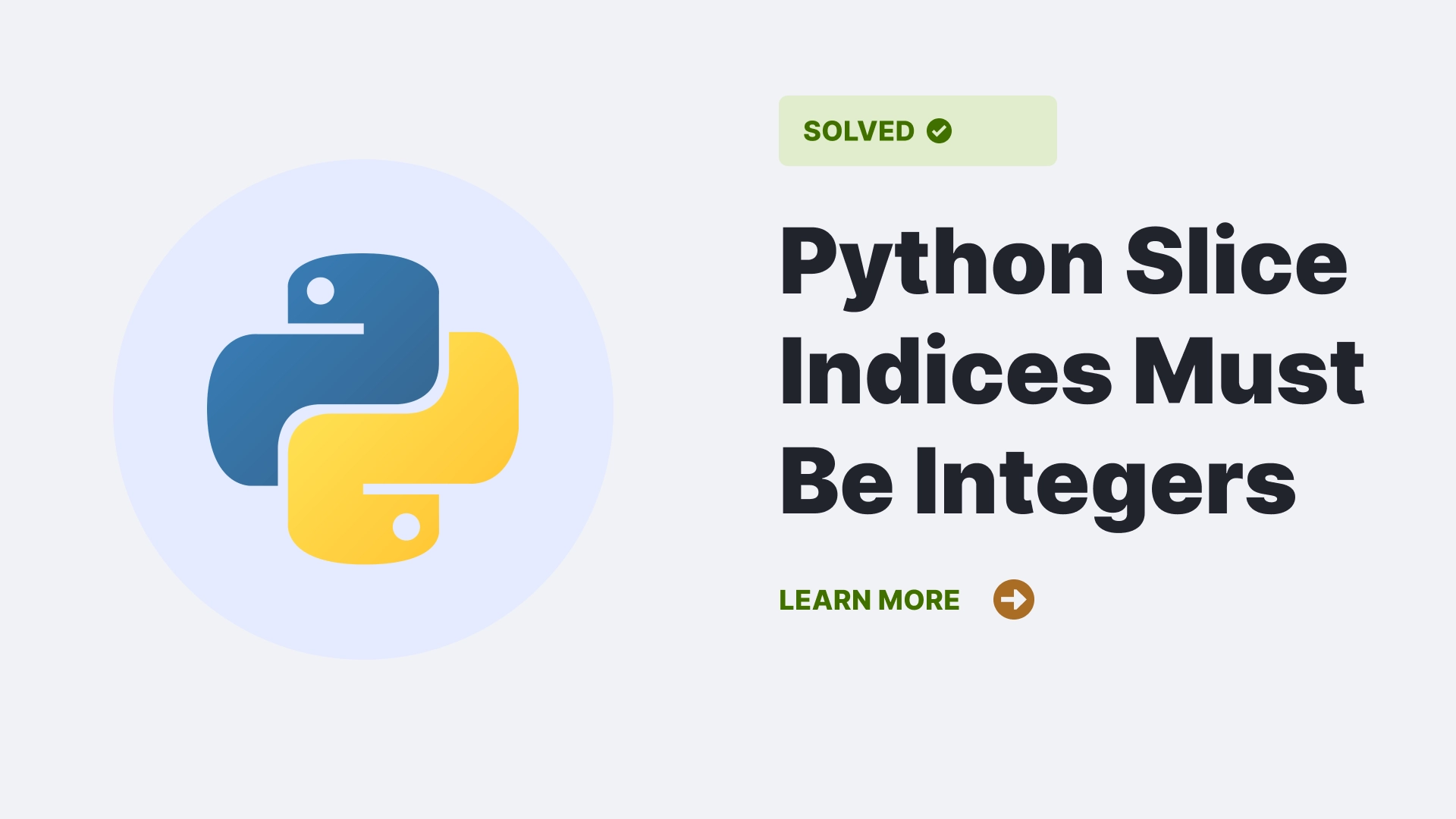In Python, slice indices must be integers. The indices used for slicing in Python must be integers or expressions that evaluate to integers. Slicing allows you to extract a portion of a sequence, such as a string, list, or tuple.
Contents
What are slice indices?
The slice indices are used to specify the range of elements one wants to extract from a sequence (e.g., a string, list, or tuple) using slicing. Slice indices consist of three components: start, stop, and step.
Python was first released in 1991, and slicing was already present in the language from its initial versions. The slice notation and the ability to extract sub-sequences using indices have been core aspects of Python’s design and syntax since its early days.
Syntax:
sequence[start:stop:step]Components of slice indices in Python
Here’s a breakdown of each component:
- start: The index of the first element you want to include in the slice. It is inclusive, meaning the element at this index will be part of the slice.
- stop: The index of the element where the slice will stop. It is exclusive, so the element at this index will not be included in the slice.
- step (optional): The increment between indices. By default, it is 1. It determines how many elements to skip between each included element in the slice.
It’s important to note that all three components (start, stop, and step) can be omitted, and they have default behaviors:
- If start is omitted, it defaults to the beginning of the sequence (index 0).
- If stop is omitted, it defaults to the end of the sequence (index len(sequence)).
- If step is omitted, it defaults to 1.
my_list = [1, 2, 3, 4, 5]
# Basic slicing examples
print(my_list[1:4]) # Output: [2, 3, 4]
print(my_list[:3]) # Output: [1, 2, 3]
print(my_list[2:]) # Output: [3, 4, 5]
print(my_list[::2]) # Output: [1, 3, 5]
# Negative indices and reverse slicing
print(my_list[-2:]) # Output: [4, 5]
print(my_list[::-1]) # Output: [5, 4, 3, 2, 1]
my_string = "Hello, World!"
# Slicing a string
print(my_string[7:12]) # Output: WorldUse of Python slice indices
In Python, slice integers are used as indices to extract specific elements or sub-sequences from sequences such as strings, lists, or tuples. Here are some common use cases and examples of slice integers in Python:
Extracting a sub-sequence:
my_list = [1, 2, 3, 4, 5]
sub_list = my_list[1:4] # Extract elements at indices 1, 2, and 3
print(sub_list) # Output: [2, 3, 4]
Copying a sequence:
my_string = "Hello, World!"
copy_string = my_string[:] # Copy the entire string
print(copy_string) # Output: Hello, World!
Reversing a sequence:
my_string = "Hello, World!"
copy_string = my_string[:] # Copy the entire string
print(copy_string) # Output: Hello, World!
Skipping elements:
my_string = "Hello, World!"
every_second_char = my_string[::2] # Extract every second character
print(every_second_char) # Output: HloWrdNegative indices:
my_list = [1, 2, 3, 4, 5]
last_two_elements = my_list[-2:] # Extract the last two elements
print(last_two_elements) # Output: [4, 5]
Modifying a sequence:
my_list = [1, 2, 3, 4, 5]
my_list[1:4] = [10, 20, 30] # Replace elements at indices 1, 2, and 3
print(my_list) # Output: [1, 10, 20, 30, 5]
Why Python slice indices must be integers?
Python slice indices must be integers because they are used as a way to reference specific elements or sub-sequences within a sequence (e.g., strings, lists, tuples). The requirement for integer indices is a design decision in Python to provide a clear and unambiguous approach to slicing.
Here are a few reasons why slice indices are restricted to integers:
- Sequence indexing: Sequences in Python, such as lists and strings, are implemented as ordered collections of elements. To access or manipulate these elements efficiently, a consistent and predictable indexing scheme is needed. Restricting slice indices to integers ensures that the indexing operation remains well-defined and unambiguous.
- Discrete position identification: Indices represent the position of an element within a sequence. Integers provide a straightforward and discrete way to identify positions. Non-integer values, such as floating-point numbers or strings, introduce ambiguity and make it harder to determine the exact element or sub-sequence being referenced.
- Computational efficiency: Using integers as slice indices allows for efficient memory addressing and indexing operations. Integer indices can be directly translated into memory offsets or array indices, enabling fast and optimized access to elements.
FAQs
What are indices?
Indices, in the context of programming and data structures, refer to the position or location of an element within a sequence or collection. They are used to access or refer to specific elements within an ordered set of data.
What happens if Python slice indices are non-integers?
It is important to note that Python slice indices must be integers or valid expressions that evaluate to integers. If we try to use non-integer values as indices, such as floating-point numbers or strings, a TypeError is encountered indicating that slice indices must be integers.
Conclusion
By enforcing that the Python slice indices must be integers, maintains a consistent and reliable indexing mechanism that is widely applicable across various sequence types. It promotes code readability, simplicity, and efficient implementation of slicing operations.
Over the years, Python has evolved with new versions and enhancements, but the slice indices technique has remained a consistent and fundamental aspect of the language’s syntax and functionality. It continues to be an essential tool for working with sequences in Python.
References
Slicing. W3Schools.
Follow PythonClear for more.

